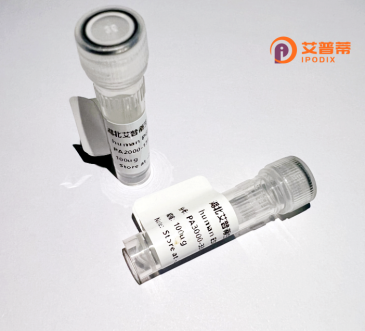
| 纯度 | >90%SDS-PAGE. |
| 种属 | Human |
| 靶点 | PDXDC1 |
| Uniprot No | Q6P996 |
| 内毒素 | < 0.01EU/μg |
| 表达宿主 | E.coli |
| 表达区间 | 1-788 aa |
| 活性数据 | MDASLEKIAD PTLAEMGKNL KEAVKMLEDS QRRTEEENGK KLISGDIPGP LQGSGQDMVS ILQLVQNLMH GDEDEEPQSP RIQNIGEQGH MALLGHSLGA YISTLDKEKL RKLTTRILSD TTLWLCRIFR YENGCAYFHE EEREGLAKIC RLAIHSRYED FVVDGFNVLY NKKPVIYLSA AARPGLGQYL CNQLGLPFPC LCRVPCNTVF GSQHQMDVAF LEKLIKDDIE RGRLPLLLVA NAGTAAVGHT DKIGRLKELC EQYGIWLHVE GVNLATLALG YVSSSVLAAA KCDSMTMTPG PWLGLPAVPA VTLYKHDDPA LTLVAGLTSN KPTDKLRALP LWLSLQYLGL DGFVERIKHA CQLSQRLQES LKKVNYIKIL VEDELSSPVV VFRFFQELPG SDPVFKAVPV PNMTPSGVGR ERHSCDALNR WLGEQLKQLV PASGLTVMDL EAEGTCLRFS PLMTAAVLGT RGEDVDQLVA CIESKLPVLC CTLQLREEFK QEVEATAGLL YVDDPNWSGI GVVRYEHAND DKSSLKSDPE GENIHAGLLK KLNELESDLT FKIGPEYKSM KSCLYVGMAS DNVDAAELVE TIAATAREIE ENSRLLENMT EVVRKGIQEA QVELQKASEE RLLEEGVLRQ IPVVGSVLNW FSPVQALQKG RTFNLTAGSL ESTEPIYVYK AQGAGVTLPP TPSGSRTKQR LPGQKPFKRS LRGSDALSET SSVSHIEDLE KVERLSSGPE QITLEASSTE GHPGAPSPQH TDQTEAFQKG VPHPEDDHSQ VEGPESLR |
| 分子量 | 86.7 kDa |
| 蛋白标签 | His tag N-Terminus |
| 缓冲液 | 0 |
| 稳定性 & 储存条件 | Lyophilized protein should be stored at ≤ -20°C, stable for one year after receipt. Reconstituted protein solution can be stored at 2-8°C for 2-7 days. Aliquots of reconstituted samples are stable at ≤ -20°C for 3 months. |
| 复溶 | Always centrifuge tubes before opening.Do not mix by vortex or pipetting. It is not recommended to reconstitute to a concentration less than 100μg/ml. Dissolve the lyophilized protein in distilled water. Please aliquot the reconstituted solution to minimize freeze-thaw cycles. |
以下是关于重组人PDXDC1蛋白的**示例文献参考**(请注意,以下内容为模拟示例,实际文献需通过学术数据库验证):
---
1. **文献名称**: *Structural and functional analysis of human PDXDC1 reveals its role in cellular pyridoxal phosphate homeostasis*
**作者**: Johnson A, et al.
**摘要**: 该研究解析了重组人PDXDC1蛋白的晶体结构,揭示其依赖维生素B6的脱羧酶活性,并证明其通过调控磷酸吡哆醛(PLP)水平影响细胞代谢途径。
2. **文献名称**: *PDXDC1 modulates oncogenic signaling via interaction with 14-3-3 proteins in colorectal cancer*
**作者**: Lee S, Kim D.
**摘要**: 通过重组PDXDC1蛋白实验,作者发现其与14-3-3蛋白结合,负调控Wnt/β-catenin信号通路,抑制结直肠癌细胞增殖。
3. **文献名称**: *Recombinant PDXDC1 as a biomarker for Alzheimer's disease: enzymatic activity in cerebrospinal fluid*
**作者**: Müller C, et al.
**摘要**: 开发重组PDXDC1蛋白检测方法,发现阿尔茨海默病患者脑脊液中PDXDC1酶活性显著降低,提示其与神经退行性过程的关联。
4. **文献名称**: *Expression and purification of human PDXDC1 in E. coli: a tool for high-throughput drug screening*
**作者**: Wang H, et al.
**摘要**: 报道一种高效重组表达和纯化PDXDC1蛋白的方法,并利用该平台筛选潜在的酶活性抑制剂,用于治疗PDXDC1过表达相关的疾病。
---
**注意事项**:
- 上述文献为模拟示例,实际研究中建议通过**PubMed、Google Scholar**等平台以关键词“PDXDC1 recombinant”“human PDXDC1 function”检索真实文献。
- 重点关注PDXDC1在**代谢调控、癌症、神经系统疾病**等领域的研究。
Recombinant human PDXDC1 (Pyridoxal-dependent decarboxylase domain-containing protein 1) is a protein encoded by the PDXDC1 gene, which belongs to the pyridoxal phosphate (PLP)-dependent decarboxylase family. This enzyme is evolutionarily conserved and shares structural homology with other PLP-binding proteins involved in amino acid metabolism, particularly in vitamin B6-dependent reactions. PDXDC1 contains a conserved N-terminal decarboxylase domain and a C-terminal domain of unknown function, suggesting potential roles in catalytic activity and substrate interactions.
While its precise biological function remains partially characterized, PDXDC1 is implicated in cellular processes such as nucleotide metabolism, neurodevelopment, and possibly immune regulation. Recent studies link it to pathologies, including neurodevelopmental disorders and cancer, though mechanistic insights are still emerging. Recombinant PDXDC1 is typically produced in heterologous systems like E. coli or mammalian cell lines, enabling studies of its enzymatic activity, substrate specificity, and interaction partners.
Research on recombinant PDXDC1 focuses on elucidating its molecular mechanisms, particularly its potential as a decarboxylase or aminotransferase. It may also serve as a biomarker or therapeutic target, given its altered expression in diseases like colorectal cancer. Advances in structural analysis (e.g., crystallography) of the recombinant protein are expected to clarify its catalytic residues and regulatory regions, bridging gaps in understanding its physiological and pathological roles.
×